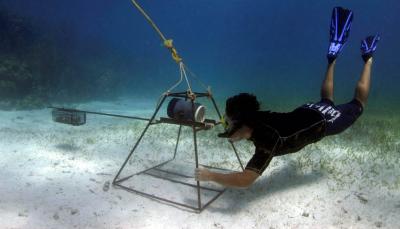A research team at the Institute for Ocean Conservation Science at Stony Brook University employed videos to enumerate the number of Caribbean reef sharks (Carcharhinus perezi) existing within and outside the marine reserves on the Caribbean Sea’s Mesoamerican Barrier Reef.
 Lead author of the study, Mark Bond of the Institute for Ocean Conservation Science at Stony Brook University, positions one of the baited remote underwater video cameras, nicknamed “chum cams,” down current at Glover’s Reef Marine Reserve. Credit: Institute for Ocean Conservation Science at Stony Brook University
Lead author of the study, Mark Bond of the Institute for Ocean Conservation Science at Stony Brook University, positions one of the baited remote underwater video cameras, nicknamed “chum cams,” down current at Glover’s Reef Marine Reserve. Credit: Institute for Ocean Conservation Science at Stony Brook University
Over 200 baited remote underwater video (BRUV) cameras were employed to collect data in the form of survey. The BRUV cameras, nicknamed ‘Chum cam’ were used by the scientists to compare the relative abundance of reef sharks in two marine reserves with that of the two fishing areas. The sharks were found to be more abundant in the reserves.
In the journal PLoS ONE, the conclusions of the five-year research titled ‘Reef sharks exhibit site-fidelity and higher relative abundance in marine reserves on the Mesoamerican Barrier Reef’ was released. The objective of the research was to determine the hypothesis based on the abundance of carcharhinid shark species such as requiem and whaler sharks within no-take marine reserves, where fishing is restricted. By using BRUV surveys, analysis on the hypothesis was carried out to determine the number of reef sharks. The calculated result was combined with acoustic monitoring to measure its site fidelity in Belize- based Caye Caulker Marine Reserve, Glover's Reef Marine Reserve, and two fishing-allowed reefs.
The safely-enclosed video cameras, equipped with small bait-filled cages in the anterior, were installed on the sea bed. The sharks, sensing the bait’s smell swam towards the cameras, which enabled the research team to record, enumerate and evaluate shark populations in the marine reserves with that of fishing- allowed areas.
Besides BRUV surveys, the scientists installed acoustic transmitters to 34 reef sharks where their movements were detected and scrutinized using moored underwater listening stations. Both juvenile and adult sharks were found to thrive throughout a year within the reserves.